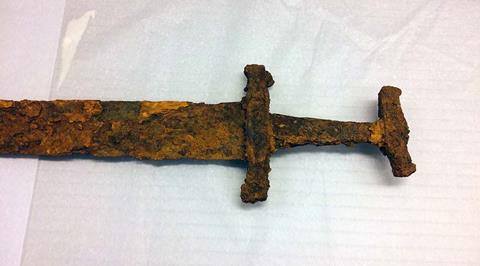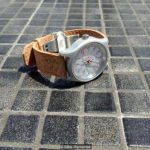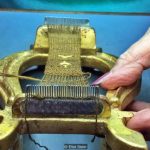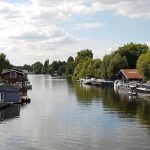1000 Years Old Viking Boat Found in Norway
Norway 1000 Years Old Viking Boat Found: 1000 Years Old Viking Boat Found in Norway, with more than 13 feet which unearthed with bones and sheet inside it.
Moreover, during excavation, a tomb was founded beneath the Market square of Norwegian city of Trondheim. Besides, regarding to the Coup report, unfortunately none of the vessel’s wood remains, between the 7th and 10th centuries AD, preserved lumps of rust and nails indicate a boat buried at the site. Also, the ships a Viking’s most prized possession, and if a high born clansman did not die at the sea, he would buried in a ship on land, and it is interesting to know that all the weapons and pottery buried with them too. In addition, to long bones found, in the process of newly uncovered grave which pointed north to South.
- Viking Ship
Location
Archaeologists in Norway say they have discovered the remains of a 1,000-year-old Viking ship beneath the soil of a farm on the island of Edøy in Møre and Romsdal County. Also, the ship, which dates back to the Viking Period or the Merovingian period, was found with the help of a high-resolution, ground-penetrating georadar. Furthermore, the radar also revealed the remains of two houses, which were likely part of a Viking settlement.
In addition, remains of the ship, which is up to 55-feet-long, are located just below the topsoil of what was a burial mound. The mound appeared up in the georadar data as a circle that was 59 feet in diameter. Also, at the center of the mound, the radar detected a 42-feet-long long keel and traces of two strakes.
History
The Vikings operated throughout northern Europe between 793–1066 AD. Infamous for their vicious raiding and pillaging of new lands, they also know for their trading. Neither would have been possible without a reliable means of transportation.
An introduction to the Vikings’ long ships
The northerners looked to the seas as a convenient and accessible way to explore and trade. Moreover, this concentration saw them develop extremely skilled ship building techniques and advanced sailing skills that were far ahead of their time.
Also, over the course of around 250 years, seafaring Norsemen left their homes to pursue riches abroad. Besides, the era has become almost legendary and left a lasting legacy on the world. But how much do you know about the long history of the Vikings?
When it comes to the history of Norway and Scandinavia, few times are more iconic than the Viking Age. So, the fascination with this time in history continues at pace, and its cultural legacy lives on.
Expertise
The ship found by archaeologists from the Norwegian Institute for Cultural Heritage Research (NIKU). Besides,the discovery made by mere chance, according to the archaeologists, as they were surveying a smaller around the medieval Edøy Church nearby. “We had actually finished the agreed upon area, but we had time to spare and decided to do a quick survey over another field,” said NIKU Archaeologist Dr. Manuel Gabler. “It turned out to be a good decision.”
Moreover, ship graves covered by mounds a form of burial reserved for Viking dignitaries. Besides, the larger the mound, the more important the person was. Also, in 2018, archaeologists at NIKU used a similar georadar to unearth another millennium-old Viking ship near the Jell Mound in Østfold County in southeastern Norway. Furthermore, the ship hidden beneath just 1.6 feet of topsoil.
“We only know of three well-preserved Viking ship burials in Norway, and these were excavated a long time ago,” said Dr. Knut Paasche, Head of the Department of Digital Archaeology at NIKU and an expert on Viking ships. “This new ship will certainly be of great historical significance and it will add to our knowledge as it can be investigated with modern means of archaeology.”
New Discoveries
Moreover, news of the Edøya ship discovery made headlines around the world last autumn. Also, now archaeologists have finished reviewing all the georadar data from the resulting survey.
Besides, the data shows the imprint of another Viking boat, in addition to the remains of two houses and five overgrown mounds. In addition, the find could improve our understanding of Norway’s Viking history.
So, Burial sites outside rural churches are nothing unusual in Norway. But archaeologists from the Norwegian Institute for Cultural Heritage Research (NIKU) have uncovered a grave with a difference just yards from Edøy church on Edøya Island in western Norway.
Also, using breakthrough georadar technology, the team has detected traces of a ship burial and a settlement that likely dates to the Merovingian or Viking Period. “This is incredibly exciting. And again, it’s the technology that helps us find yet another ship. Besides, as the technology is making leaps forward, we are learning more and more about our past,” said Dr. Knut Paasche, head of the department of digital archaeology at NIKU.
Moreover, Paasche an expert on Viking ships and said that the new find will “of great historical significance.” Although many Viking ship graves have found over the years, only three well-preserved ships have excavated.
Besides, it is thought that Viking ship burials reserved for people of significant status in the community. Also, discoveries such as this bring new knowledge about the importance of specific places during the Viking era.
Grave is more than 1,000 years old
Last year, the same georadar technology used to find the Viking ship grave at Gjellestad. A subsequent dig earlier this year revealed some of the keel was intact and in good condition.
In addition, the discovery at Edøya bears similarities to the Gjellestad find. Also, both ships located just below the top soil in what had previously a burial mound. Besides, at the center of the 18-meter diameter mound, a 13-meter long keel is clearly visible on the georadar data. It is too early to properly date the ship, but archaeologists are confident the ship is more than 1,000 years old. Moreover, in the surroundings of the ship, archaeologists have also discovered what appears to be traces of a settlement.
Modern georadar technology-and a bit of luck
Also, the “Edøy Ship” as it dubbed by NIKU the latest in a string of recent discoveries made with an archaeological prospection approach that takes advantage of large-scale high-resolution georadar measurements. Moreover, the technology developed by the LBI ArchPro research institute and its partners, including NIKU, using technology from Guideline Geo.
Despite the recent success of the technology, there was an element of luck in the latest discovery. Bosses from the Smøla local council and Møre og Romsdal county authorities asked NIKU to perform surveys at Edøya last year. In addition, following promising results, the team returned to Edøya to survey the land around the church.
“We had actually finished the agreed upon area, but we had time to spare and decided to do a quick survey over another field. It turned out to be a good decision,” said archaeologist Manuel Gabler.
In addition, NIKU archaeologists now plan to investigate more parts of Edøya, possibly through a research project with local authorities. So, the team are also hoping for further discoveries elsewhere in Norway, as there are many promising areas of great historical importance.

























































































